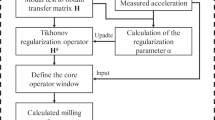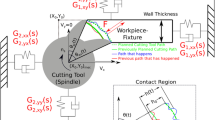Abstract
Online measurement of milling force is very important for machining process monitoring and control. In practice, it is difficult to measure the milling force directly during the milling process. This paper develops a method for milling force identification called least square QR-factorization with the fast stopping criterion (FSC-LSQR) method, and the queue buffer structure (QBS) is employed for the online identification of milling force using acceleration signals. The convolution integral of milling force and acceleration signals is discretized, which turns the problem of milling force identification into a linear discrete ill-posed problem. The FSC-LSQR algorithm is adopted for milling force identification because of its high efficiency and accuracy, which can effectively handle the linear discrete ill-posed problem. The online identification of milling force can be realized using the acceleration signal enqueue and the milling force dequeue operations of the QBS. Finally, the effectiveness of the method is verified by milling tests under different milling parameters.


















Similar content being viewed by others
Data availability
It can be obtained from the author by mail.
References
Cao HR, Zhang XW, Chen XF (2017) The concept and progress of intelligent spindles: A review. Int J Mach Tools Manuf 112:21-52. https://doi.org/10.1016/j.ijmachtools.2016.10.005
Wang B, Liu ZQ, Cai YK, Luo XC, Ma HF, Song QH, Xiong ZH (2021) Advancements in material removal mechanism and surface integrity of high speed metal cutting: A review. Int J Mach Tools Manuf 166:103744. https://doi.org/10.1016/j.ijmachtools.2021.103744
Feng J, Sun Z, Jiang Z, Yang L (2016) Identification of chatter in milling of ti-6al-4v titanium alloy thin-walled workpieces based on cutting force signals and surface topography. Int J Adv Manuf Technol 82(9-12):1909-1920. https://doi.org/10.1007/s00170-015-7509-0
Jullien-Corrigan A, Ahmadi K (2020) Measurement of high-frequency milling forces using piezoelectric dynamometers with dynamic compensation. Precis Eng 66:1-9. https://doi.org/10.1016/j.precisioneng.2020.07.001
Rizal M, Ghani JA, Nuawi MZ, Hassan C, Haron C (2015) Development and testing of an integrated rotating dynamometer on tool holder for milling process. Mech Syst Signal Process 52:559-576. https://doi.org/10.1016/j.ymssp.2014.07.017
Jeong YH, Cho DW (2002) Estimating cutting force from rotating and stationary feed motor currents on a milling machine. Int J Mach Tools Manuf 42:1559-1566. https://doi.org/10.1016/S0890-6955(02)00082-2
Aslan D, Altintas Y (2018) Prediction of cutting forces in five-axis milling using feed drive current measurements. IEEE/ASME Transactions on Mechatronics 23(2):833-844. https://doi.org/10.1109/TMECH.2018.2804859
Kim D, Jeon D (2011) Fuzzy-logic control of cutting forces in CNC milling processes using motor currents as indirect force sensors. Precis Eng 35:143-152. https://doi.org/10.1016/j.precisioneng.2010.09.001
Chen YL, Tao Y, Hu P, Wu L, Ju BF (2021) Self-sensing of cutting forces in diamond cutting by utilizing a voice coil motor-driven fast tool servo. Precis Eng 71:178-186. https://doi.org/10.1016/j.precisioneng.2021.03.009
Song KY, Wang M, Liu LM, Wang C, Zan T, Yang B (2020) Intelligent recognition of milling cutter wear state with cutting parameter independence based on deep learning of spindle current clutter signal. The Int J Adv Manuf Technol 109:238-243. https://doi.org/10.1007/s00170-020-05587-1
Castro LR, Vieville P, Lipinski P (2006) Correction of dynamic effects on force measurements made with piezoelectric dynamometers. Int J Mach Tools Manuf 46(14):1707-1715. https://doi.org/10.1016/j.ijmachtools.2005.12.006
Kim JH, Chang DC, Jang DY (2005) Cutting force estimation by measuring spindle displacement in milling process. CIRP Annals 54(1):67-70. https://doi.org/10.1016/S0007-8506(07)60051-1
Kim LH (2008) Dynamic cutting force on-line estimation using a 4-electrode cylindrical capacitive displacement sensor mounted on a high speed milling spindle. J Mech Sci Technol 22:914-923. https://doi.org/10.1007/s12206-008-0214-2
Albrecht A, Park SS, Altintas Y, Pritschow G (2005) High frequency bandwidth cutting force measurement in milling using capacitance displacement sensors. Int J Mach Tools Manuf 45(9):993-1008. https://doi.org/10.1016/j.ijmachtools.2004.11.028
Zhou J, Mao XY, Liu HQ, Li B, Peng YL (2018) Prediction of cutting force in milling process using vibration signals of machine tool. The Int J Adv Manuf Technol 99:965-984. https://doi.org/10.1007/s00170-018-2464-1
Salehi M, Albertelli P, Goletti M, Ripamonti F, Tomasini G, Monno M (2015) Indirect model based estimation of cutting force and tool tip vibrational behavior in milling machines by sensor fusion. Procedia CRIP 33:239-244. https://doi.org/10.1016/j.procir.2015.06.043
Hamid M, Chaneel IP, Guseon K, Simon SP, Dong YL (2021) Reconstruction of cutting forces through fusion of accelerometer and spindle current signals. Journal of Manufacturing Processes 68:990-1003. https://doi.org/10.1016/j.jmapro.2021.06.007
Spiewak SA (1995) Acceleration based indirect force measurement in metal cutting processes. Int J Mach Tools Manuf 35(1):1-17. https://doi.org/10.1016/0890-6955(95)80005-0
Korkmaz E, Gozen BA, Bediz B, Ozdoganlar OB (2017) Accurate measurement of micromachining forces through dynamic compensation of dynamometers. Precis Eng 49:365-376. https://doi.org/10.1016/j.precisioneng.2017.03.006
Chae J, Park SS (2007) High frequency bandwidth measurements of micro cutting forces. Int J Mach Tools Manuf 47(9):1433-1441. https://doi.org/10.1016/j.ijmachtools.2006.09.028
Pawelko P, Powalka B, Berczynski S (2013) Estimation of cutting force model coefficients with regularized inverse problem. Adv Manuf Sci Technol 37(2):5-21. https://doi.org/10.2478/amst-2013-0012
Wang CX, Zhang XW, Qiao BJ, Chen XF, Cao HR (2018) Milling force identification from acceleration signals using regularization method based on TSVD in peripheral milling. Procedia CIRP 77:18-21. https://doi.org/10.1016/j.procir.2018.08.195
Wang CX, Zhang XW, Qiao BJ, Cao HR, Chen XF (2019) Dynamic Force Identification in Peripheral Milling Based on CGLS Using Filtered Acceleration Signals and Averaged Transfer Functions. J Manuf Scie Eng 141(6):064501. https://doi.org/10.1115/1.4043362
Morigi S, Reichel L, Sgallari F, Zama F (2006) Iterative methods for ill-posed problems and semi-convergent sequences. J Comput Appl Math 193:157-167. https://doi.org/10.1016/j.cam.2005.05.028
Rao SS and Yap FF (2011) Mechanical Vibrations (5th Edition). https://doi.org/10.1017/S0001924000067099
Meurant G (2006) The lanczos and conjugate gradient algorithms. SIAM, Philadelphia. https://doi.org/10.1017/S096249290626001X
Reichel L, Sadok H, Zhang WH (2020) Simple stopping criteria for the LSQR method applied to discrete ill-posed problems. Numer Algorithms 84:1381-1395 https://doi.org/10.1007/s11075-019-00852-1
Hanke M (2001) On lanczos based methods for the regularization of discrete ill-posed problems. BIT Numerical Mathematics 41:1008-1018. https://doi.org/10.1023/A:1021941328858
Gupta GK, Banerjee A (2019) On finite buffer bulk arrival bulk service queue with queue length and batch size dependent service. Int J Appl Comput Math 5(2). https://doi.org/10.1007/s40819-019-0617-z
Wan M, Yin W, Zhang WH, Zhang WH, Liu H (2017) Improved inverse filter for the correction of distorted measured cutting forces. Int J Mech Sci 120:276-285. https://doi.org/10.1016/j.ijmecsci.2016.11.033
Bauer F, Kindermann S (2008) The quasi-optimality criterion for classical inverse problems. Inverse Problems 035002. https://doi.org/10.1088/0266-5611/24/3/035002
Park Y, Reichel L, Rodriguez G, Yu X (2018) Parameter determination for Tikhonov regularization problems in general form. J Comput Appl Math 343(1):12-25. https://doi.org/10.1016/j.cam.2018.04.049
Funding
This work is supported by the National Natural Science Foundation of China (No. 51922084).
Author information
Authors and Affiliations
Contributions
Maxiao Hou: conceptualization, methodology, writing–original draft, software. Hongrui Cao: writing–review and editing, supervision, project administration, funding acquisition. Qi Li: resources, methodology. Jianghai Shi: writing–review and editing
Corresponding author
Ethics declarations
Ethical approval
Not applicable.
Consent to participate
Not applicable.
Consent for publication
Not applicable.
Conflict of interest
The authors declare no competing interests.
Rights and permissions
Springer Nature or its licensor holds exclusive rights to this article under a publishing agreement with the author(s) or other rightsholder(s); author self-archiving of the accepted manuscript version of this article is solely governed by the terms of such publishing agreement and applicable law.
About this article
Cite this article
Hou, M., Cao, H., Li, Q. et al. Industry-oriented method for dynamic force identification in peripheral milling based on FSC-LSQR using acceleration signals. Int J Adv Manuf Technol 121, 7793–7809 (2022). https://doi.org/10.1007/s00170-022-09697-w
Received:
Accepted:
Published:
Issue Date:
DOI: https://doi.org/10.1007/s00170-022-09697-w




